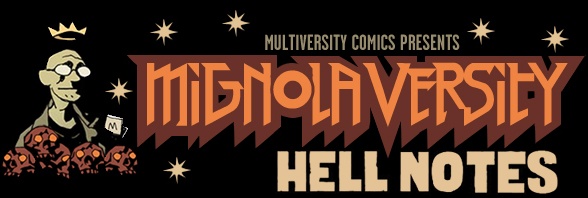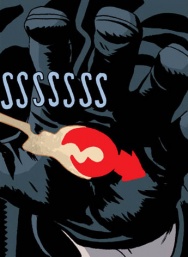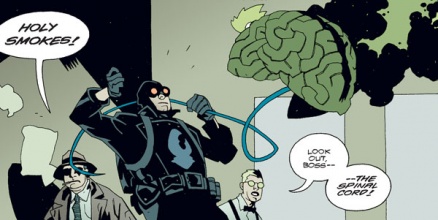

Please note, this column contains spoilers for those that have not yet read up to and including Lobster Johnson: Get the Lobster #1.
THE EARLY 1930s


Police were utterly baffled to find bodies of gangsters dressed as native Americans with claw symbols branded on their foreheads. Less baffled was reporter Cindy Tynan of the Herald Tribune, who set out to get to the bottom of it all and in the process made herself a target. Luckily for her, the Lobster had a wary eye on her and came to her rescue. It was primarily through Cindy’s eyes that we were introduced to the Lobster and his world in this story. His headquarters in a warehouse in Brooklyn showed how serious the Lobster was with crime fighting. He seemed ready for a war, and had amassed a crew to help him.


Wald’s henchmen claimed to have shot him multiple times, but when the Lobster emerged he appeared unharmed, although he did keep to the shadows. Perhaps they never hit him at all. Meanwhile, Arnie Wald escaped and had Mr Isog call in a mystic, Kamala, and her husband, Raimund Diestel, to take his cheap property plan to the next level. Those of you who read my column last week will know Raimund Diestel was an incarnation of the Black Flame.
Raimund began burning buildings and causing general mayhem, so it wasn’t long until the Lobster showed up, guns blazing, yelling, “There’s a special circle in Hell for arsonists! You can test out your black fire when you get there!” I just love the Lobster’s dialogue and the way he recklessly throws himself into harm’s way. Sadly, Lobster Johnson’s crew members sometimes think they are just as invincible and end up getting themselves killed.

Meanwhile the Lobster had killed all of Wald’s men and Wald had fled, leaving only the Black Flame. The Lobster, never one to take half measures, took care of him by shooting him with an anti-aircraft gun…

The Black Flame was revived almost immediately by Kamala, but when Cindy Tynan showed up and ran her down, he lost the will to fight. As for Wald and Isog, those two managed to escape when they tricked the Lobster into a house full of cannibals.




In A Scent of Lotus he came up against the Crimson Lotus (a witch, an Axis agent, and Captain Daimio’s grandmother). She had a bunch of weird-looking monkeys with mask-like faces at her disposal. For me, this story is the creepiest, and I can chalk it all up to one panel… the one to the right there.
Seeing the Lobster screaming, and seeing that glimpse of an eye behind his goggles ran a chill down my spine. Those who see the Crimson Lotus usually do not survive to tell anyone, so that the Lobster saw her alone should give you an idea how much danger he was in. This encounter led to the Lobster catching J. Edgar Hoover’s attention and that of his Federal Bureau of Investigation. We’ll see how that plays out in Get the Lobster.
Speaking of which, yesterday’s issue had some very interesting developments. The Lobster is now in the hideout we’ve seen in flashbacks from B.P.R.D., and Bill and Bob have finally joined the team. We’ve entered the Lobster’s golden age. Oh, and there’s also a cyborg wrestler, and a vicious dwarf with scars all over his head, and mysterious shadowy figures watching the Lobster from a rooftop. It’s kicked off to a great start.

THE LATE 1930s

We’re going to jump from 1934 to June 1937, to the first Lobster Johnson miniseries, The Iron Prometheus. Professor Kyriakos Gallaragas and his daughter Helena had been working on a prototype Vril Energy Suit powered by a device known as “Anum’s Fork.” For the last three weeks they had hired a Mr Jim Sacks as a lab assistant, a rather unusual choice since he only had a fifth-grade education. When strange men broke into their laboratory, Jim was sent away with the V.E.S. to stop it falling into the wrong hands. He was pursued by Nazi agents, monks that can turn themselves into yetis, and the Lobster. Lucky for him, the Lobster got to him first.
Continued below
While Jim was kept in the safety of the Lobster’s sewer hideout, the Lobster started looking into the strange monks tracking the V.E.S.. They were the Chutt, a legendary tribe a warriors and madmen, led by a man who called himself Memnan Saa. Memnan Saa has a long history in the Hellboy universe from 1836 until his death in B.P.R.D.: The Black Goddess. He was one of the primary antagonists during the Plague of Frogs cycle, and here in The Iron Prometheus he was already setting grand plans in motion as he tried to obtain Anum’s Fork so that he could summon Vril. With the Lobster on his trail, Memnan Saa’s hideout was soon located.

Meanwhile, the Lobster was left fighting Dr Waxman, an old enemy he thought he had left for dead back in early 1935, and Victor, some sort of cyborg with lobster-like mechanical arms. Just when he had the upper hand (or claw), the Lobster was entangled by a giant snake and a vision of Memnan Saa warned him: “I have no quarrel with you. You cross me this one time, but I would have you survive it … so long as you never raise a hand against me.” The Lobster replied by dropping a grenade and blowing the building apart. Spectators observed that no one could have survived the explosion, and yet the Lobster did, even though he was right on top of it, restrained by a giant serpent. There is clearly more than just good luck at work here.


In 1938, in the first Lobster Johnson story to be published, The Killer in My Skull, Detective Norvell Cooper was investigating the deaths of four scientists from Zinco-Davis Laboratories. In this story Detective Cooper didn’t recognise the Lobster’s associate Bob, but he seemed to recognise the Lobster himself well enough, so this story is likely set in the early days of Cooper’s interactions with The Lobster. Unlike the police earlier in the Lobster’s career, Detective Cooper was extremely co-operative. Together they tracked former Zinco-Davis employee, Stanley Corn, and battled his giant brain of doom. At the Lobster’s advice, Detective Cooper never wrote up a report on the incident and destroyed all evidence.

1938 wasn’t all giant brains and mad scientists though. The Lobster and his crew were still hunting Memnan Saa. Then Bill fell down some stairs, hit his head, and died. Lester was stung by a non-lethal African scorpion while asleep in London and subsequently died. Bob was found after he had apparently hung himself. At this point the Lobster stopped his search. With only Harry left, he had had enough. The pair of them worked on two final cases after that, then President Roosevelt recruited him.
Continued below
March 20, was the last mission of the Lobster. He was sent to Hunte Castle in Austria to put a stop to the Nazi space program. When he and the American troops with him attacked, there was an explosion. It was believed all parties were killed, bringing the Lobster’s career to a close. Afterwards the U.S. government denied the existence of the Lobster or any of his rumoured missions for them.
FROM THE LOBSTER TO LOBSTER JOHNSON


The Lobster also had some time on the silver screen beginning with 1945’s “The Phantom Jungle,” a thirteen-part serial which inexplicably placed the Lobster in Africa on the trail of mad scientists and fighting mutant Altanteans. It was described by critics as “amazingly terrible.” A second serial was much more faithful to the source material, returning the Lobster to New York City and based loosely on Norvell Cooper’s novel “Empire of Death.” The Lobster was portrayed in both serials by Vic Williams, a former singing cowboy who was clearly far too old and too heavy for the part.

In 1951, the Lobster returned again, this time as Lobster Johnson, a series of Mexican films by writer/director Eduardo Fernandez. The addition of Johnson to the title appears to have been taken from the Lobster’s alter-ego from the original novels by Norvell Cooper, but Lobster Johnson is a markedly different character to the one that appeared in the pulps.

There were no surviving good prints of the original films, however there were rumours acclaimed Mexican filmmaker Guillermo del Toro was interested in a big-budget remake of the franchise. Whether there was any truth to these rumours is unknown, and the recent hell that has been unleashed across the globe makes it unlikely any such film will eventuate in the near future.
Continued belowTHE 2000s

On the way up the mountains to Hunte Castle, Hellboy, Roger, and their guide, Laura Karnstein, encountered an elderly Nazi wandering aimlessly in the snowy mountains. He was executed by Laura (actually Inger von Klempt, granddaughter of Nazi scientist, Herman von Klempt who was a part of the Nazi space program). Now this is where it gets strange. The corpse of this Nazi later got up and turned into the Lobster, then began hunting down Nazis, killing them and burning the Lobster claw symbol onto their foreheads.

When he encountered Roger, he recognised him as an ally, and the two proceeded into Hunte Castle fighting side by side. The Lobster informed Roger that the sole survivor of the Hunte Castle incident, Herman von Klempt, was alive and at work in the castle. The Lobster’s choice of words were curious, as they implied he himself did not survive.
During the Conqueror Worm’s emergence from the space capsule, the Lobster guided Roger, drawing his attention to where it was most needed. While Hellboy and Roger dealt with the Conqueror Worm and von Klempt, the Lobster hunted down Inger and killed her. And when Roger was being eaten from the inside out by the Conqueror Worm, he aided Hellboy in saving him, sacrificing his own life in the process.



Johann was possessed again in B.P.R.D.: The Black Goddess. Like before, he used this opportunity to strike out at Memnan Saa, although this time his efforts were far more futile.

Ultimately it was Liz that killed Memnan Saa, and with no way to strike at his enemy, it seemed the Lobster became stuck, unable to relinquish his possession of Johann’s ectoplasm. Unlike the Lobster that appeared in Conqueror Worm, this form seems to only be partially aware of his surroundings, often talking to himself or giving nonsensical replies when spoken to.
Kate Corrigan and her boyfriend at the time, Bruno Karhu, travelled back to Austria in B.P.R.D.: King of Fear in an attempt to free the Lobster’s spirit and return Johann back to normal. The took him to the place where Roger and Hellboy had buried him several years earlier. The Lobster stood before his own grave, commenting that he felt sad. But taking him to his grave did not bring him peace, and it did not free Johann. It was only when the Lobster found the spirits of the Nazis that had died in Hunte Castle that he could finally let Johann go, as he launched himself into battle with those ghosts, determined to inflict justice.
And just like that the Lobster was gone, leaving us with a whole heap of questions.

THE LOBSTER’S CREW
Before I get to the questions, I want to take a moment to shine the spotlight on the Lobster’s crew. These characters are a huge part of the Lobster’s mythology, and they absolutely deserve a mention.
Continued below
Between Get the Lobster and The Iron Prometheus there is a definite physical change in Harry. It appears his jaw has been broken and never quite set the same, and his posture has become slumped. It seems to me that he has taken some injuries that never quite healed.


By 1933, in A Scent of Lotus, Lester had found his bravery, ready to charge into a burning building where the Lobster was fighting an Axis agent. He even made himself a target of the Crimson Lotus’s wrath when he took her picture, proving that she exists.
Lester was a bit of a fanciful guy. He enjoyed reading “Astounding Stories of Super Science” and was ready to believe in Atlanteans and spaceships at a moment’s notice. When the Lobster began tracking Memnan Saa, his job was to follow leads abroad, a task that led to his death by non-lethal scorpion.


Theo, a Romanian with an easy-going attitude, was tasked with guarding Cindy Tynan. He kept her company for three days secreted away in a hotel room before she tricked him and sneaked out. It was lucky that she did too, because the hotel room was blown up by Mr Isog shortly after.


Bob died after he had apparently hanged himself in 1938 while investigating Memnan Saa.

There’s no sign of Cindy in the later stories. Did something happen to her, or was she simply not involved in those stories? She’s a character I really enjoy, so I admit this makes me a little nervous.

WHAT IS THE LOBSTER?

It’s a crazy theory, I know, and one I don’t have a lot of confidence in to be honest, but I went back and checked. Every time the Lobster is apparently in a situation in which he’d be killed, there was always a corpse that had just had the Lobster’s justice inflicted on it nearby. Unfortunately, in the Hunte Castle incident, all the bodies were destroyed in an explosion, leaving the Lobster without a body… until sixty-one years later when Inger executed the surviving Nazi in the mountains, finally serving justice on him.
Justice is very important to the Lobster. When he was prevented from killing Memnan Saa in The Black Goddess he became trapped in Johann’s ectoplasm. He was left wondering, “Justice. Where is the justice?” Then, when he was in Hunte Castle and found the spirits of all the dead Nazis, he said, “There. There it is,” and his spirit was freed. This concept of justice is more than just his drive, it seems tethered to his very soul.

I’m a little vague on the finer points of this theory, because it is a crazy one. But then, whatever Mignola has in mind is pretty crazy too, as he said in an interview with Comic Book Resources last December:
Continued below“One thing we discussed when John started the book was me saying: Here is my ‘true history’ ― and ‘true history’ was in major quotes ― for Lobster Johnson’s family tree. It’s weird. It’s intended to be something that if you heard it, you’d go, ‘That can’t possibly be true.’ And you can use it or not . . . So my major contribution is that I tried to throw in some really weird shit that, amazingly, John is using.”
If you’re like me, you’re wondering what he meant by “Lobster Johnson’s family tree.” And maybe we’ll start getting more clues about that in Get the Lobster. Back in April, Mignola had this to say about the Lobster’s origins:
“I did make up a background for Lobster Johnson. I just didn’t know that we’d ever use it. But when John started writing the book, I said, ‘If we involve a character like a reporter’ ― which was John’s idea ― ‘should we ever get around to her digging in to who this character is, that’s maybe the one way to explain a little bit of who he is.’ “
Well, she’s certainly digging in the first issue. I wonder what she’ll uncover… But in the meantime, I really want to hear theories, especially the really wild ones.

THE FUTURE OF THE SERIES
The other thing that came out in CBR’s December interview with Mignola was him talking about the finite length of the Lobster Johnson series. After all, the Lobster was only active for seven years, and the first three are nearly done already. We already know how Lobster Johnson’s story ends, and Mignola confirmed in his interview, the final Lobster Johnson story will likely serve as a lead in to Conqueror Worm, but between now and then there’s still so much to do!
In Spring 1935, the Lobster is due to come across Dr Waxman and the Cossaro brothers. Eventually he’s got to meet Norvell Cooper and have a few adventures that stretch the limits of credibility (and possibly destroy a famous New York landmark). And at some point he and Harry are going to bump into the Steel Hawk and a German with pet alligators and a some rather interesting clothes.

Not only that, but so far all of the Lobster’s stories have taken place in New York City, but he also spent some time in Chicago. Hell, I’d love a whole trade of short stories in Chicago. Yeah, Lobster Johnson in Chicago sounds like a great trade…
Speaking of trades, Lobster Johnson – Volume 3: Satan Smells a Rat will be out next Wednesday. You’ll definitely want to pick that one up.

Another Hell Notes done! That was the longest one I’ve ever done (not something I want to make a habit of). As usual, I’m all for theories. Feel free to talk about Lobster Johnson, his crew, and the many plot threads unfolding in Get the Lobster in the comments section below. I’ll be back with another Hell Notes in March. It’s going to be a big month for Mignolaversity…






